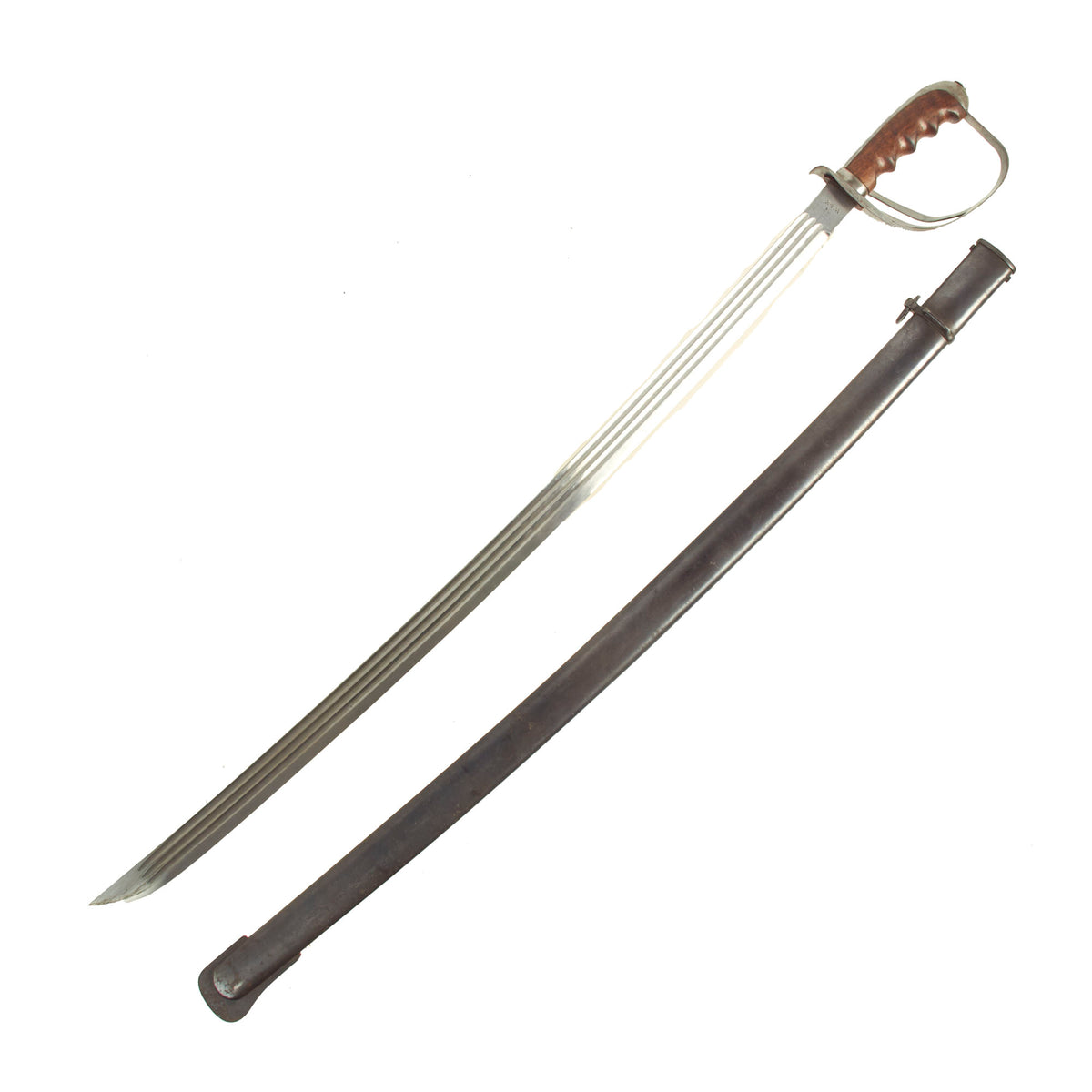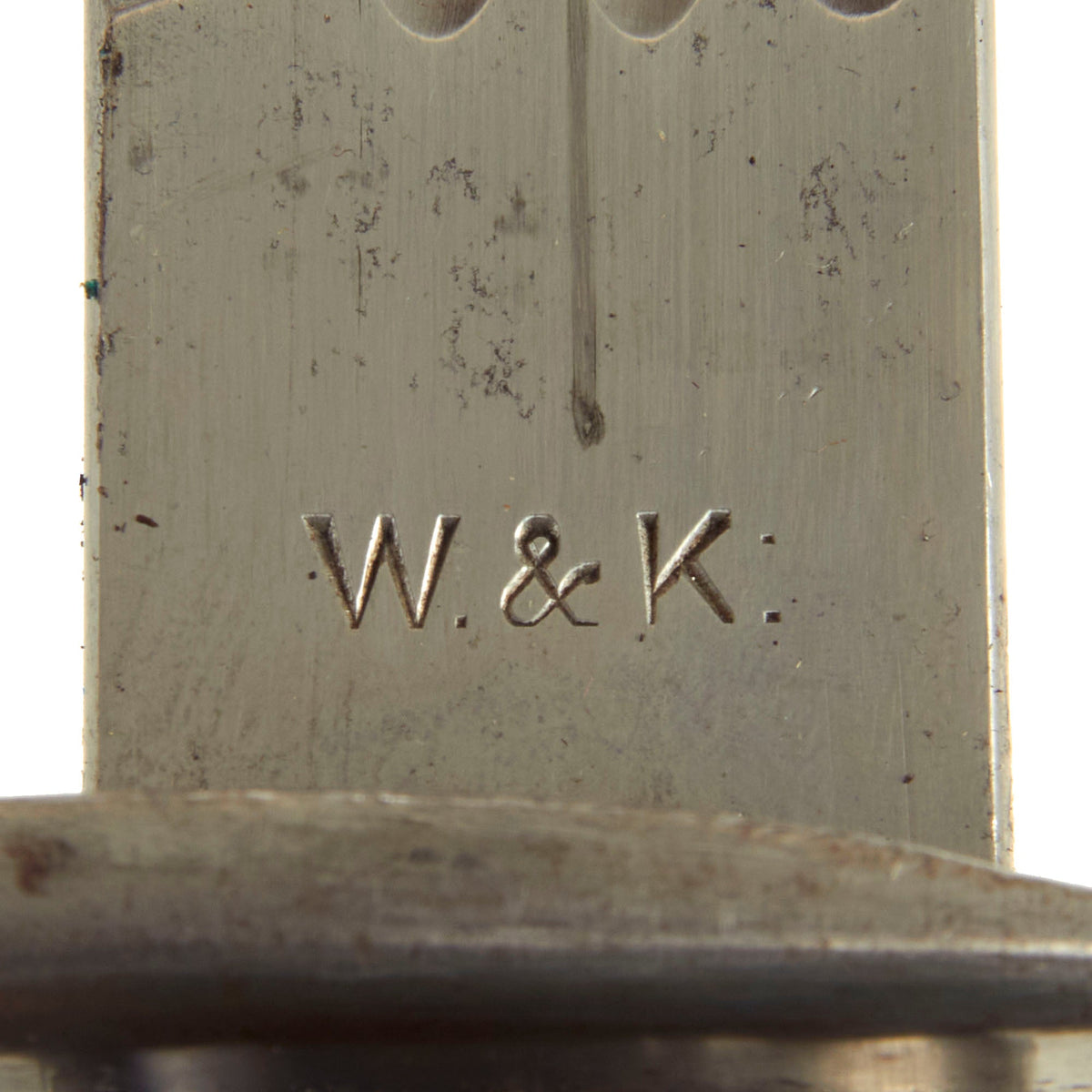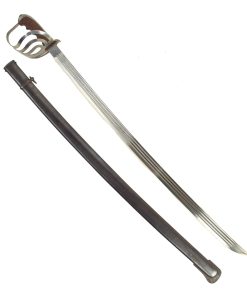Original German Pre-WWII Weimar Republic Experimental Reichswehr Cavalry Saber by Weyersberg Kirschbaum & Co. with Scabbard – dated 1929 Original Items
$ 1.495,00 $ 373,75
Original Item: Only One Available. During the years immediately following the Armistice that ended WWI, German industry as a whole was in shambles. The country was occupied by the Allied powers, and there were severe restrictions on anything related to weapons construction. However, Germany still did need to have armed forces of some level, and did continue to pattern and design new weapons.
This is a fantastic extremely rare experimental cavalry saber, designed for the Reichswehr Armed forces of Weimar period Germany. It looks to have never been issued, and we can find very little information about it at all, however the sword does a very good job of speaking for itself. The design looks to feature an Italian style basket hilt and wooden grip, mated with a heavy TRIPLE FULLERED Swiss-style slightly curved blade. Still contained in its original blued steel scabbard, this is an impressive looking weapon, as well as a great research opportunity!
The sword has a 32 1/4″ bright steel blade, gently curved with Swiss-style triple fullers. The blade is in excellent condition, and still has the original unsharpened factory blunt edge. There is just the tiniest bit of oxidation speckling, and no signs of use.
This great example was made by Weyersberg Kirschbaum & Co. of Solingen, the legendary “City of Blades” in western Germany. The reverse ricasso is stamped with the simplified W. & K. marking used during this time along with W. u. K.”. This company is a famous manufacturer of military swords and cutlery in Solingen, Germany – a city famous since the middle ages for its metal-working and craftsmanship in sword making. Per J. Anthony Carter’s fine work GERMAN SWORD AND KNIFE MAKERS, the traditional manufacturing of swords at WKC dates back to the year 1774 when the Weyersberg first registered the ”Kings head” as their trademark. Later in 1883 the company merged with the Kirschbaums and the company Weyersberg Kirschbaum & Cie was formed, which continued into the Weimar Period until it declared bankruptcy in 1930. It then rebranded as W.K.C. Waffenfabrik GmbH, and produced many edged weapons during the NSDAP Period. The company is still in operation today.
The spine of the blade is marked with a Weimar “Stick Eagle” over 46, which is marked on the back of the grip and the grip ferrule as well. There are additional proofs on other parts of the sword. The base of the blade is also marked 29, for 1929, just before W & K Co. declared bankruptcy. The basket and grip of the sword is in great shape, with a lovely grain on the wooden grip.
The included heavy blued steel scabbard is in very good condition, with no dents or other issues, just speckled oxidation on the exterior. The hanger loop is present next to the square fitting for the belt hook.
A fantastic rare experimental Interwar Period sword by Weyersberg Kirschbaum & Co.. Ready to research and display!
Specifications:
Blade Length: 32 1/4″
Blade Style: Single Edge w/ Triple Fullers
Overall length: 37 3/4“
Guard: 5″L x 5 “W
Scabbard Length: 33 1/2″
The Weimar Republic (German: Weimarer Republik), officially the German Reich (Deutsches Reich), also referred to as the German People’s State (Deutscher Volksstaat) or simply the German Republic (Deutsche Republik), was the German state from 1918 to 1933. As a term, it is an unofficial historical designation that derives its name from the city of Weimar, where its constitutional assembly first took place. The official name of the republic remained the German Reich as it had been during the German Empire because of the German tradition of substates.
Although commonly translated as “German Empire,” Reich here better translates as “realm” in that the term does not necessarily have monarchical connotations in itself. The Reich was changed from a constitutional monarchy into a republic. In English, the country was usually known simply as Germany, and the Weimar Republic name became mainstream only in the 1930s.
The Reichswehr (English: Realm Defense) formed the military organization of Germany from 1919 until 1935, when it was united with the new Wehrmacht (Defense Force). At the end of World War I, the forces of the German Empire were disbanded, the men returning home individually or in small groups. Many of them joined the Freikorps (Free Corps), a collection of volunteer paramilitary units that were involved in suppressing the German Revolution and border clashes between 1918 and 1923.
The Reichswehr was limited to a standing army of 100,000 men, and a navy of 15,000. The establishment of a general staff was prohibited. Heavy weapons such as artillery above the caliber of 105 mm (for naval guns, above 205 mm), armored vehicles, submarines and capital ships were forbidden, as were aircraft of any kind. Compliance with these restrictions was monitored until 1927 by the Military Inter-Allied Commission of Control.
The Reichsheer was the Army Division of the Reichswehr.
Fast Shipping with Professional Packaging
Thanks to our longstanding association with UPS FedEx DHL, and other major international carriers, we are able to provide a range of shipping options. Our warehouse staff is expertly trained and will wrap your products according to our exact and precise specifications. Prior to shipping, your goods will be thoroughly examined and securely secured. We ship to thousands clients each day across multiple countries. This shows how we're dedicated to be the largest retailer on the internet. Warehouses and distribution centres can be located throughout Europe as well as the USA.
Note: Orders with more than one item will be assigned a processing date depending on the item.
Before shipping before shipping, we'll conduct a thorough inspection of the items you have ordered. Today, the majority of orders will be delivered within 48 hours. The delivery time will be between 3-7 days.
Returns
The stock is dynamic and we cannot completely manage it because multiple stakeholders are involved, including our factory and warehouse. So the actual stock may alter at any time. It's possible that you may not receive your order once the order has been made.
Our policy is valid for a period of 30 days. If you don't receive the product within 30 days, we are not able to issue a refund or an exchange.
You can only return an item if it is unused and in the same state as the day you received it. You must have the item in its original packaging.
Related products
Uncategorized
Uncategorized
Uncategorized
Uncategorized
Armored Burgonet Helmet & Polearm from Scottish Castle Leith Hall Circa 1700 Original Items
Uncategorized
Uncategorized
Uncategorized
Uncategorized
Uncategorized
Uncategorized
Uncategorized
Uncategorized
Uncategorized
Uncategorized
Uncategorized
Uncategorized
Uncategorized
Uncategorized
Angolan Rebel 1970s era 60mm Inert Display Mortar from Angolan Civil War Original Items
Uncategorized













































































